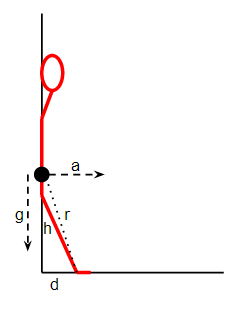Here's what's bugging me for quite a long time. Imagine the every day situation, that you are standing in a bus with your back on wall having only limited space on the floor and no handle to hold. You are quite ok for acceleration effects in 3 of 4 directions. You will not fall behind, the wall is there. Right and left direction is relatively easily handled by a wide stance, but you are troubled about falling forward. Now how would you stand to be able to withstand the acceleration effects the most effectively?
As it is probably a bit too vague (and maybe not completely understandable), let me elaborate it and put some numbers just to demonstrate the situation. Consider a normal human (average height and normal vertical weight distribution, if a notion like this exists) and let's state that the limitation on the floor space is defined as 50 cm from the wall. You cannot put your feet further, because someone is standing there.
If we skip all exotic and unnatural stances, we are basically left with two extremes and a continuum between them. One extreme is that you are standing with your legs straight, second extreme is that you squat (let's consider here you will not go below the point, when your legs are in parallel with the floor) (and let's ignore how inconvenient this stance is).
My physical imagination is too weak to at least guess, which of these stances is more stable, I just don't suspect seeing optimum somewhere between (but not sure about that either). I also don't have any idea, how it should be calculated and if it's something rather trivial, or something very hard.
Here's a picture of what I was speaking about. Figure on the left is what I eventually do in the bus, figure on the right is what comes intuitively to me as better way (center of mass is lower and maybe the angles are more favorable). So.. is it better to bend the knees (even a bit)?


